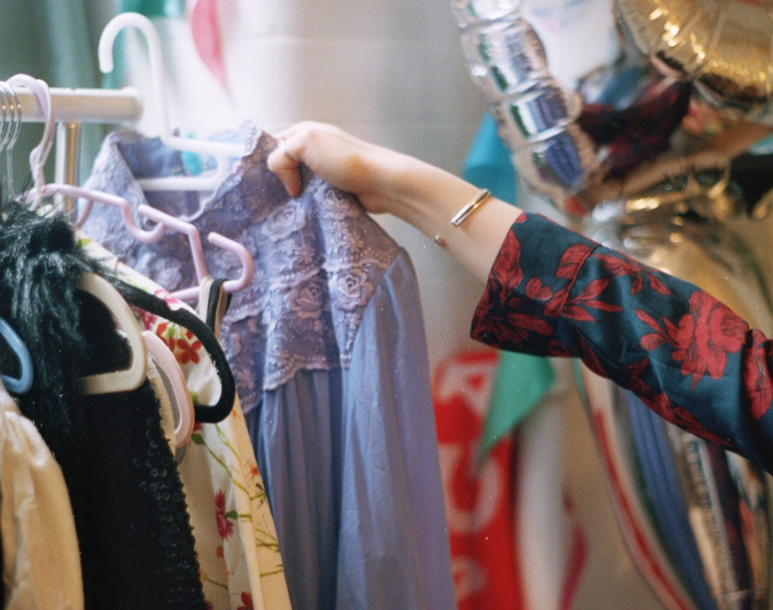A reflection on why clothes swapping is the next best alternative to not buying at all, as well as how and where to swap your clothes in Singapore.
‘Hand-me-downs’ is a term familiar to most Singaporeans. We’ve all received clothes that our older siblings or cousins had outgrown. Growing up, I had inadvertently participated in this ritual of passing clothes on to my friends and family. In return, I received clothes that they no longer needed. As a slow fashion advocate, I am on the journey of slowing down my own fashion consumption. So, to make that actionable, I organised a cosy ‘Swap Not Shop’ clothes swapping event in conjunction with Fashion Revolution Week 2019 in April.

Why swap?
We need to understand that swapping our clothes out does not mean that we cannot afford to buy something new. It means we cannot afford to throw something away. It means we are normalising the idea of second-hand clothing.
Clothes swapping is the simplest way to give your clothes a new lease of life. Not only is it a cost-free alternative to buying new clothes, but it also revitalises your wardrobe without spending a dime. What is there not to love about a cosy afternoon with pre-loved clothes, like-minded people, and homemade snacks and drinks?
Singaporeans urgently need to be more active participants in the solution to minimise the effects of the ‘throwaway culture’. Yet, this culture is so deeply ingrained in us. Choosing to swap your pre-loved clothes is a way to actively vote against consuming new clothes. Hence, it is the perfect #haulternative and the least you could do to replace traditional shopping methods.

Why not shop?
By now, you might be aware of the detrimental socio-environmental impacts that come from ambiguously made clothes. (Watch Tammy Gan’s video on how fashion kills here) Mass-producing fast fashion companies moved the bulk of their manufacturing to countries. For instance, China, Bangladesh, Cambodia, and Vietnam. Back home, most Singaporean fashion labels never disclose who made their clothes. They continue releasing new collections every week, with little to no consideration of sustainability and ethics. Why? This is to satisfy the demand derived from our pursuit of new clothes which gives us instant gratification. Moreover, this feeling that is addictive and self-fulfilling, so we come back wanting more. What further worsens it is micro-trends they deliberately create.
“Modern consumers are short-distance runners who only stay for the getting-to-know-you period when all is fresh, new and novel,” says Jonathan Chapman. This came from an article titled after the binge, the hangover published in Fashion Revolution Fanzine #2. He is also the author of the book Emotionally Durable Design. Left unworn, these clothes are discarded irresponsibly and without care. Eventually, we end up with piles of clothes with absolutely no idea what to do with them.
According to Channel News Asia, Singapore discarded more than 205,800 tonnes of textiles in 2018. Also, we only recycle 6% of them. Of every 34 pieces of new clothing bought, 27 are discarded. So, this brings us to a state of desolation. Each year we throw away almost the same amount textiles that we make. This is because we are enabled by the convenience of purchasing from fast fashion retailers. Hence, vast numbers of clothes are bought without much consideration for the longevity of the clothes’ worn cycle.
Therefore, clothes swapping is a slower, more considered and circular manner of acquiring new items. Knowing where your clothes will end up is as important as knowing who made them.

So what can you do?
“Contrary to what some people think, sustainability is not a trend”, said London-based fashion designer Christopher Raeburn. He spoke at a panel discussion with Jacket Required, an urban fashion trade show held in East London earlier this year. “We need to sizeably change what’s happening in our industry.” So, if you care, take matters into your own hands and try organising your own small-scale clothing swap or attend one with your friends.
If you are looking to organise your own small-scale clothes swap event, here’s a flexible and non-exhaustive guide:
Create a Facebook event, invite friends and ask them to bring along their friends, the more the merrier
> Have a comfortable and sheltered location i.e. your living room or any communal space
> Provide sufficient racks to display dresses, coats, trousers, and tables for tops and accessories
> Make sure you have enough hangers (I crowd-sourced them from my flatmates and my own wardrobe)
> Enough changing rooms for swappers to try on clothes – important! This makes sure that the decision to swap has been well thought about
> Some snacks and drinks (fun cocktails always make people happy) to go around, or even make it a potluck and have attendees bring homemade food to share
Or you can check out some of our favourite swappers like The Fashion Pulpit, The Dayre Clothes Swap, and Your Clothes Friend Swap.
I cannot be more thankful for the attendees who believed in ‘Swap Not Shop’ and spent time together with me on that windy Saturday afternoon. I could not have done it without my supportive friends and flatmates who helped me put everything together.
Clothes swapping surely isn’t as convenient as placing an order online or stepping into a visually stunning shop front to buy something off the racks. But I can guarantee that a clothes swap is far more enjoyable and fulfilling than any shopping spree. A zero cost and low waste method of acquiring new clothes shouldn’t require any more persuasion. Let us take a stand against fast fashion and give our landfills a break.
Images courtesy of Trishna Goklani
